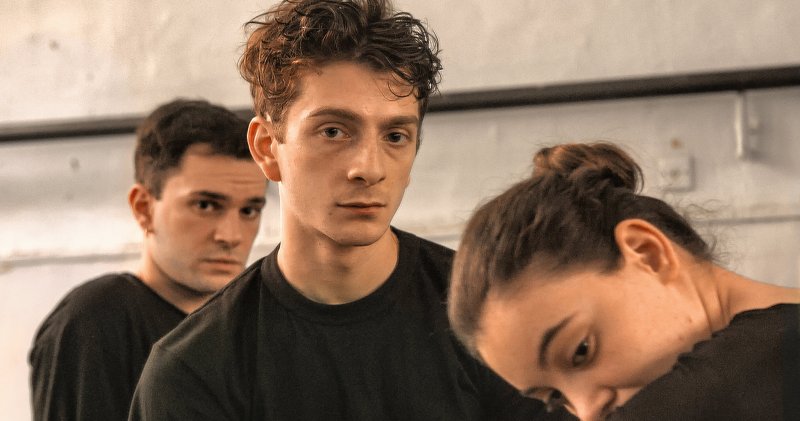This article is the first in a series of three articles on the 30th Hamburg International Queer Film Festival (Lesbisch Schwule Filmtage Hamburg), taking place from October 15, 2019, to October 20, 2019. The festival is Germany’s oldest and largest queer film festival.
Premiering in the Directors’ Fortnight at Cannes 2019, Levan Akin’s Swedish-Georgian drama “And Then We Danced” is a one-of-a-kind queer coming of age film. Subtly sensual, it channels a certain youthful energy that moves it away from “Call Me By Your Name” by diving into the unrelenting, culturally and emotionally charged landscape of Georgian dance.
Admittedly, it may not have the narrative cleanliness of “CMBYN,” but it more than makes up for it with its complex and rewarding character depictions. Merab (Levan Gelbakhiani), a brilliant dancer at the National Georgian Ensemble begins to grow envious of the new dancer in the group: the effortlessly talented, self-righteous Irakli (Bachi Valishvili). Naturally, Merab sees Irakli’s kindness and dance advice as sycophantic, which it may start as, but quickly turns into a back-and-forth sexual tension-filled face-off as they try to one-up each other in a game of dominance — for each other.
Gelbakhiani brings a joyous, youthful, floaty quality to his performance that evokes the no-holds-barred thrill of a first love through his gracefulness and ferocity alike. (He’s got that Chalamet boyish charm, complete with nearly the same hair, but Georgian dance? Timothée Chalamet could never!) He’s beautifully unrestrained, trying and failing to hide his hidden smiles and sneak looks at Irakli. And at the same time, he’s emotive and free, even with the perils of being caught, with the dangers and stakes of being outed decidedly higher within the context of this film than many others.
In a lovely foreshadowing, Merab and Irakli are paired together for a dance, and immediately, the tension is palpable. They’re clearly incredible together, their energy and perceived hatred for each other fueling the dance — but, of course, what Merab thinks is rage is a certain kind of passion.
Merab is in a loose relationship with Mary, (Ana Javakishvili) his close friend, but he’s clearly only half-heartedly into it. Mary catches on, but it’s her resulting reactions to Merab’s sexual interests that truly makes her one of the most beloved characters of the film. Irakli’s “got a girl” in his hometown, so naturally he can’t engage with other women — but Merab isn’t off limits. However, Irakli is perhaps too careless for the hopeless romantic Merab as the latter begins to explore his sexuality — going to a gay club while intoxicated, gently encouraged by gender-binary-breaking sex workers he meets (who were actual sex workers recruited by the director after he met them).
Aside from stunning and engaging dance sequences, the performance element of the film allows for freedom of expression beyond the spoken word. In a beautiful, emotional scene, Merab dances freely for Irakli, unbound by societal or cultural expectations for what masculine dance is supposed to look or feel like.
In some ways, it’s ”Black Swan” but with actual dancers, allowing for the camera to travel everywhere, unrestricted. The camera traces over bodies and more bodies, but it’s the camera’s reluctance to leave these bodies that’s perhaps the most striking. We’re always in a close-up, torso up or closer, whether it be faces, arms, or feet. The camera can’t take its eyes off of Merab and Irakli, itself becoming an instrument of intimacy — we can feel every twitch, see every blink, hear every breath.
Furthermore, “And Then We Danced” does away with tired tropes of performance while depicting the deeply engrained constraints of patriarchy. For the Georgian dance ensemble leadership, dancing is tradition, and dancing is proudly masculine. But Merab is told that he’s too heavy on his feet and is demanded to be lighter and more in control. At another point, he’s told that the style changed about 50 years ago to the more “masculine” style it is today, and that he must be stiffer and stronger. Like with his sexuality, Merab is unable to live up to every impossible expectation.
Perhaps the film doesn’t wrap up its storylines as cleanly as it could, but boy, the end scene will have you clapping. Screw the patriarchy. Screw gendered society. This might be a crude description of an otherwise straightforward and effective scene, but Akin knows how to go out with a bang; it’s the payoff of the film’s slow and steady construction of dance as cinematic language. “And Then We Danced” is also a great example of why sitting through the credits often reveals important information about the film. The choreographer is listed as anonymous, which Akin himself has discussed is because revealing the choreographer’s involvement in the film — which itself has been boycotted due to its queer content — might lead to discrimination and harassment.
Ultimately where “And Then We Danced” really succeeds is how it portrays adolescent queer allyship in a beautiful, honest light. The emotional impact of acceptance and support from key characters (won’t spoil!) in Merab’s case is absolutely overwhelming. It instills a certain kind of hope that even when hate, distrust, and taught and learned, there’s something deeper that pulls at you — where love and truth do trump any lingering doubt that what society tells you is correct is, in fact, correct.
“And Then We Danced” will have a limited American theatrical release in early 2020.
Contact Olivia Popp at oliviapopp ‘at’ stanford.edu.
